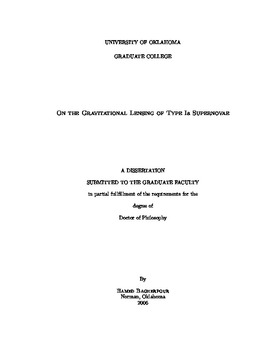| dc.contributor.advisor | Kantowski, Ronald, | en_US |
| dc.contributor.author | Bagherpour, Hamed. | en_US |
| dc.date.accessioned | 2013-08-16T12:20:20Z | |
| dc.date.available | 2013-08-16T12:20:20Z | |
| dc.date.issued | 2006 | en_US |
| dc.identifier.uri | https://hdl.handle.net/11244/1074 | |
| dc.description.abstract | In this dissertation we concentrate on some of these effects on the observation of type Ia supernovae. | en_US |
| dc.description.abstract | Gravitational lensing has turned out to be an active field in astronomy, both as an abstract subject and a means to better understand and study other astronomical topics. One of the main applications of gravitational lensing is the broad field of supernovae observation. It is shown that lensing can have dramatic effects on how supernovae are observed, and therefore appear as an inevitable 'noise' in any (deep) survey carried out for purposes such as determining the equation of state for the so-called dark energy. | en_US |
| dc.format.extent | xiii, 88 leaves : | en_US |
| dc.subject | Physics, Astronomy and Astrophysics. | en_US |
| dc.subject | Microlensing (Astrophysics) | en_US |
| dc.subject | Supernovae. | en_US |
| dc.title | On the gravitational lensing of type Ia supernovae. | en_US |
| dc.type | Thesis | en_US |
| dc.thesis.degree | Ph.D. | en_US |
| dc.thesis.degreeDiscipline | Homer L. Dodge Department of Physics and Astronomy | en_US |
| dc.note | Source: Dissertation Abstracts International, Volume: 67-06, Section: B, page: 3177. | en_US |
| dc.note | Adviser: Ronald Kantowski. | en_US |
| ou.identifier | (UMI)AAI3222153 | en_US |
| ou.group | College of Arts and Sciences::Homer L. Dodge Department of Physics and Astronomy | |
